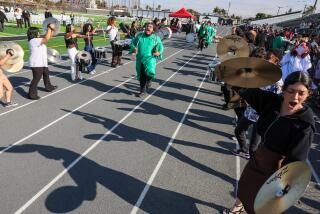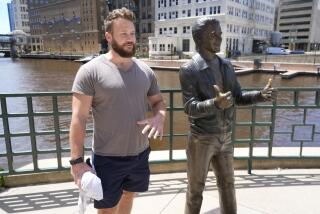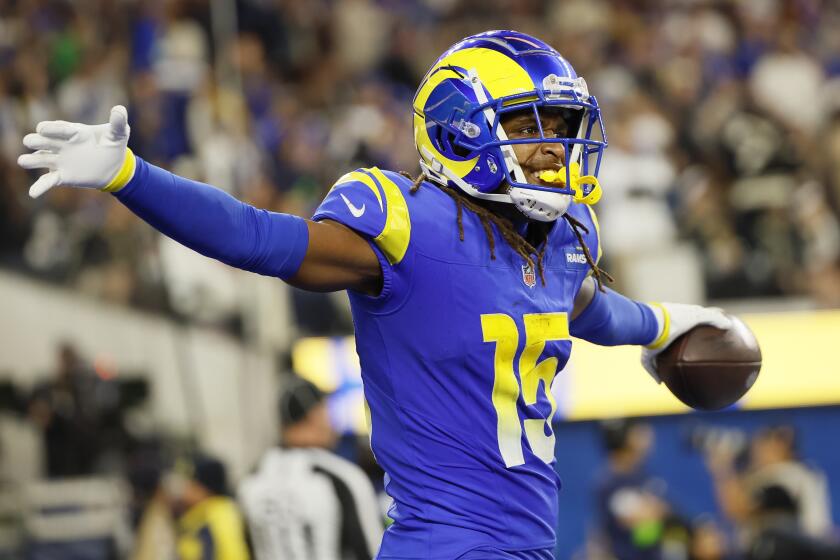Wisconsin’s Band: a Lot of Brass : College football: Marching band provides entertainment where the hapless Badgers fall short.
MADISON, Wis. — One of these days, the University of Wisconsin is going to field a football team the marching band can be proud of.
Even now, with the team struggling with a 1-9 record before Saturday under a new head coach, most Wisconsin fans can still leave 77,000-seat Camp Randall Stadium with smiles on their faces, no matter how ugly the final score.
At Wisconsin, “The Fifth Quarter” is usually far more entertaining than the previous four, one reason hardly anyone heads for the parking lot until long after the game has ended.
That’s when the marching band entertains the crowd with 45 minutes of sweet-tooting, foot-stomping, sing-along tunes. Even the security guards assigned to keep fans off the field tap their feet and occasionally join band members in impromptu do-si-dos on the sidelines.
The Wisconsin Marching Band has become an institution at this institution, thanks mostly to the efforts of Michael Leckrone, the 53-year-old son of an Indiana high-school band leader who says quite simply, “All I ever wanted to do was lead a Big Ten band down the field. My childhood fantasy came true, and now we want this to be the best band in the world.”
It is already considered by many people the best college band in the country, on a short list that would probably include the bands of Michigan State, Ohio State, Florida State, Florida A&M; and Texas. Wisconsin has had a band since 1885, when it began as an outgrowth of an ROTC program to provide music for military ceremonies. According to Leckrone, marching bands began playing at football games around the turn of the century at Illinois and Notre Dame, and many more bands started marching in formations at halftimes of college games around 1910-15.
Leckrone is a wiry, bespectacled dynamo equally adept with a baton or a pencil in his hand. He’s in constant demand as a clinician and guest conductor all over North America, and more than 200 of his arrangements and compositions for marching bands have been published. A father of five who also is a full professor in the school of music, he is beginning his 22nd year at Wisconsin. And the 250 students who turn out for the grueling hour-and-45-minute workouts will tell you he is a charismatic character and master motivator, a man who demands perfection and usually gets it.
The band practices four times a week during the football season, with preseason summer tryouts for more than 400 band hopefuls that are as nerve-racking and physically taxing on the participants as any two-a-day football practice over at the athletic complex.
No scholarships are awarded, and the one credit band members earn per semester hardly compensates for all the pulled muscles, aching backs and sore legs they suffer during the season.
They are asked to learn an incredible number of complicated formations. The block W formation is standard stuff, but Leckrone says he can chart his band “into almost anything. We do a lot of animals, we’ve done Snoopy. Last year we shot an arrow down the field and it turned around and pierced a cowboy hat we were in. We did that song “Short People’ and the band marched on its knees. When “The Gong Show” was popular, we played with bags over our heads as the unknown band.
“We had an elephant join us once. It was messy, if you know what I mean.”
Leckrone’s musicians learn immediately that it’s not enough to blow a mean trumpet or bang the drum loudly. “If you don’t show up in shape, you’re in big trouble,” says Stephan Nolten, a sophomore trombone player from Madison. “Just learning the formations can overwhelm you when you first see them. Mike yells and screams, but he knows when to back off too.
“I know this, he’ll get you to do things you never thought you could do. You go until you never thought you could go. It can get harsh out there in a full uniform, carrying an instrument and marching with those high steps. But it’s very rewarding. We’re the show, and everyone in this band takes great pride in their performance.”
The music may very well be the easy part. Most of the band members have been playing for years. They come from all different parts of the campus, with majors such as engineering, pre-law and comparative-lit students far outnumbering the music majors. Leckrone does not even have to recruit his players.
The summer tryouts are filled with eager freshmen hoping to win one of the 200 to 240 positions Leckrone marches on football Saturdays in the fall. Band members also play at basketball and hockey games, give an annual spring concert in the field house that drew more than 15,000 for two sessions last year, and travel to parades and bowl games around the country. They’ve recorded several tapes, hot sellers at the university bookstore despite their $10 price tags.
Their repertoire ranges from Mozart to Motown, Beethoven to the Beatles, and all notes in between. A few weeks ago, the band had already begun to practice a halftime show with music from “Les Miserables.” But after the death of Leonard Bernstein, Leckrone switched immediately to a half-dozen numbers from “West Side Story.”
Of course, there are staples. “On Wisconsin,” the school’s often-imitated fight song, is played a dozen times during football games, sometimes more, depending how many points the team scores. But the show-stopper of them all is the band’s signature song, to the tune of the Budweiser jingle “You’ve Said It All.”
Back in the early 1970s, the band had several commercial jingles in its portfolio. At hockey games, Leckrone says, the band was always getting requests for polka music. The Budweiser song was polka-perfect and was first performed during the 1972 hockey season. A year later, when the Badgers and their scaled-down indoor band invaded Boston Garden for the NCAA championships, the crowds couldn’t get enough of it.
Fans initially would sing, “When you say Bud-weiser, you’ve said it all,” but band members decided to sing back to the crowd, “When you say Wis-consin, you’ve said it all.”
“The people loved it,” Leckrone says. “They couldn’t get enough of it, still can’t.”
In 1978, whenever the band began playing it, Wisconsin fans became so boisterous at football games, the upper deck of Camp Randall Stadium actually shook from all those feet pounding or polkaing on the concrete floor. Athletic Director Elroy Hirsch became so concerned that he asked Leckrone not to play the song until after games had ended and the stands were not nearly as packed.
That’s when “The Fifth Quarter” actually began. Fans began to linger after games, hoping to hear the song. Glenn Miller, not the big-band leader but the late sports editor of the Wisconsin State Journal, dubbed the post-game show “The Fifth Quarter” and the beat has gone on ever since.
The music is loud and boisterous, but what sets the Wisconsin band apart is the high-stepping, strutting march, known to aficionados of such things the “stomp at the top.”
Every member of the band is given music and intricate formations, with each set of instructions individually tailored to a musician’s place in line. Every row is numbered; every band member knows exactly how many steps to take and when and where to take them before pivoting in another direction.
Early this season, university officials noticed there were two worn spots, each about the size of a basketball, in the red block “W” that is at the center of the stadium’s brand-new artificial-turf field. That prematurely worn carpet came courtesy of the marching band, which used those spots as turning points in its formations.
“That’s how precise we are,” says Matt Lenz, another sophomore in the trombone section. “At first it can be kind of intimidating, but after a while, you understand that’s the kind of perfection they expect.”
That becomes terribly obvious during practice sessions. On the Friday before Wisconsin’s homecoming game against Illinois a few weeks ago, Leckrone came dressed for band practice in red sweats and a white golf shirt, with a whistle dangling around his neck.
For the first few minutes, the musicians sprawled on the ground stretching hamstrings and quads, then did several minutes of calisthenics to get into the marching mood. The first 15 minutes were used to practice for the following week’s show, with Leckrone barking orders from a stepladder conductor’s podium that allowed him to see almost everything.
What he misses, two assistant directors and a dozen field assistants stationed on the sidelines can pick up. Each row also is captained by a student musician, who may be tougher on his peers than Leckrone or any of his staff. One freshman woman substituting for an injured regular was harshly dressed down by a row captain for not playing her trombone loud enough as the band moved into its final rehearsal for the next day’s halftime show.
“If you’re just going to go through the motions, don’t bother,” he bellowed at one point. “We’ll be better off without you.” The woman was in tears momentarily, than regained her composure and performed splendidly thereafter.
Though temperatures dipped down to the high 40s and the wind off nearby Lake Mendota made it feel even chillier, many band members were in shorts, some shirtless, and as the practice wore on, sweat dripped all over the stadium’s new green rug.
Leckrone almost never stopped talking, cajoling, pleading for sharper notes, more precise steps. “Let’s go with intensity,” he said at one point, “with great intensity. It’s almost Saturday, people, it’s almost Saturday.”
And finally, at the end of the session, he gathered his band around him and said quietly: “It’s a matter of pride, a matter of pride. I will not allow you to be mediocre. People, it finally got good there, now it’s got to stay good. Do the job tomorrow.”
Later, while band members broke up into impromptu touch-football games or headed home to a hot shower, Leckrone spoke animatedly about his pride and joy, his creation, his people.
“If you strive for excellence, these kids enjoy that,” he said. “They enjoy being part of something really special, and that’s what this has become. The biggest problem I have is trying to convince some of them that they’ll have the time to do this. But once we get ‘em hooked, we’ve got ‘em.
“It’s more than just a marching band. It’s also a great social thing. We have parties, we do so many things together. We’ve even had more than our share of marriages, kids who met in the marching band.”
When Leckrone arrived 22 years ago, the band was all male. In 1974 he opened it up to everyone. Two women signed on, and slowly but surely more and more joined up.
“It took a little while for the women to overcome some of the social pressure that was part of that era,” he said. “It just wasn’t done. But I saw other bands go through legal hassles, and I didn’t want that here. The first two women we had were perfect for the program, and it hasn’t been an issue for a long time. It’s been an absolute joy.
“Now, if we can get that football team going, maybe we’ll get a little bit more exposure. These kids earned it. They deserve it.”
Indeed, when you say Wis-consin (at least the marching band), you’ve also said it all.
More to Read
Go beyond the scoreboard
Get the latest on L.A.'s teams in the daily Sports Report newsletter.
You may occasionally receive promotional content from the Los Angeles Times.










